Read and Print Lines From Txt File C++
In this commodity, nosotros are going to prove you how to read and write to a file in the C++ programming linguistic communication by using several examples. To understand C++ file operations like read and write, we must outset empathise the concept of a stream in C++.
What is a Stream?
A stream is merely a menstruum of data or characters. There are two types of streams: input streams and output streams. An input stream is used to read the data from an external input device such as a keyboard, while an output stream is used to write data to the external output device such as a monitor. A file can be considered as both an input and output source.
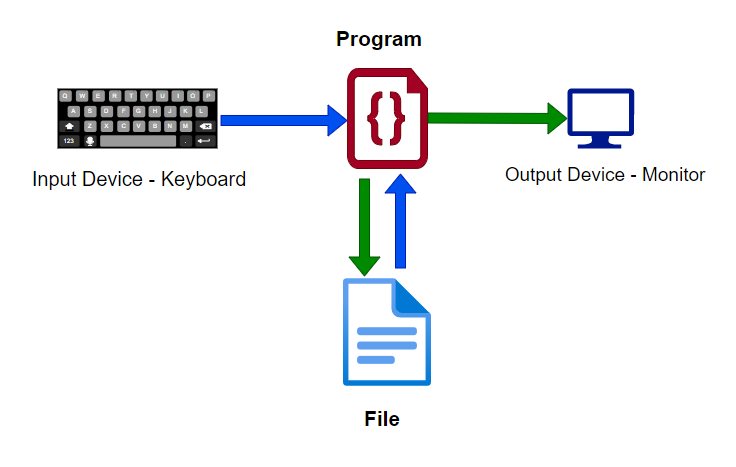
In C++, nosotros use a stream to send or to receive information to or from an external source.
We tin use built-in classes to access an input/output stream, i.e., "ios".
Hither is the stream class hierarchy of the C++ programming language:
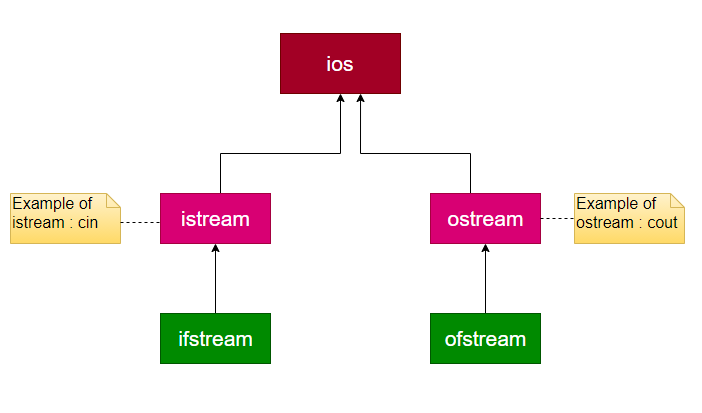
The "cin" and "cout" objects are used to read the data from the keyboard and to display the output on the monitor, respectively. In addition, "ifstream," which stands for "input file stream," is used to read a stream of information from a file, and "ofstream," which stands for "output file stream," is used to write a stream of information to a file.
The "iostram.h" file contains all the required standard input/output stream classes in the C++ programming language.
Examples
Now that you sympathise the basics of streams, we will talk over the following examples to help you to amend understand file operations in C++:
- Example ane: Open up and Close a File
- Example 2: Write to a File
- Example 3: Read from a File
- Instance 4: Read and Write to a File
- Example 5: Read and Write to a Binary File
Case one: Open up and Close a File
In this example program, we will demonstrate how to open/create a file and how to close the file in C++. Equally y'all can see in the below program, we have included the library required for file operations.
To open and shut a file, nosotros need an object of ofstream. And so, to read or write to a file, we accept to open up the file. Nosotros accept included the fstream header file at line number-ane so that we tin admission ofstream class.
Nosotros have alleged a myFile_Handler as an object of ofstream inside the main office. We tin can then use the open() office to create an empty file and the close() office to close the file.
#include <fstream>
using namespace std;
int main( )
{
ofstream myFile_Handler;
// File Open up
myFile_Handler.open up ( "File_1.txt" ) ;
// File Close
myFile_Handler.close ( ) ;
return 0 ;
}
Now, we volition compile the plan and examine the output. Equally you can see in the output window below, the "File_1.txt" file was created afterwards executing the programme. The size of the file is zero since we have not written any content in the file.
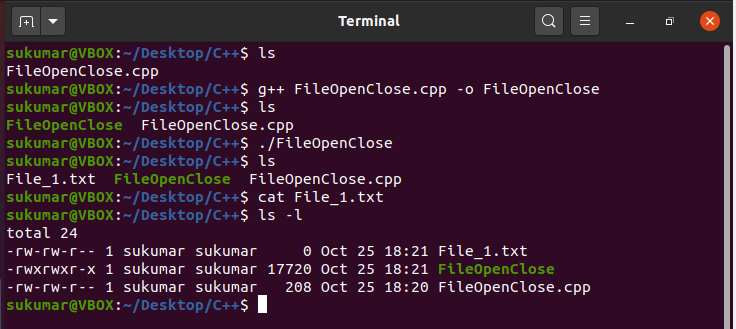
Example two: Write to a File
In the previous example plan, we showed y'all how to open a file and how to close the file. Now, nosotros will prove you how to write something in a file.
Nosotros tin write to a file using the stream insertion operator, i.east., "<<". In this program, we have used the file handler and insertion operator to write ii lines in the file. The insertion operator ("<<") indicates that nosotros are inserting the string into the output file stream object.
#include <fstream>
using namespace std;
int main( )
{
ofstream myFile_Handler;
// File Open
myFile_Handler.open ( "File_1.txt" ) ;
// Write to the file
myFile_Handler << "This is a sample test File. " << endl;
myFile_Handler << "This is the second line of the file. " << endl;
// File Close
myFile_Handler.close ( ) ;
return 0 ;
}
At present, we will compile the above program and execute information technology. As y'all can see below, we have successfully written to the file File_1.txt.

Instance 3: Read from a File
In the previous examples, nosotros showed yous how to write content to a file. Now, allow's read the content from the file that we created in Example-2 and display the content on the standard output device, i.eastward., the monitor.
We apply the getline() function to read the consummate line from the file and then "cout" to print the line on the monitor.
#include <iostream>
#include <fstream>
#include <string>
using namespace std;
int main( )
{
ifstream myFile_Handler;
string myLine;
// File Open in the Read Mode
myFile_Handler.open up ( "File_1.txt" ) ;
if (myFile_Handler.is_open ( ) )
{
// Continue reading the file
while (getline(myFile_Handler, myLine) )
{
// impress the line on the standard output
cout << myLine << endl;
}
// File Close
myFile_Handler.close ( ) ;
}
else
{
cout << "Unable to open up the file!" ;
}
return 0 ;
}
Now, we volition print the content of File_1.txt using the following control: cat File_1.txt. In one case we compile and execute the program, it is clear that the output matches the content of the file. Therefore, we accept successfully read the file and printed the content of the file to the monitor.
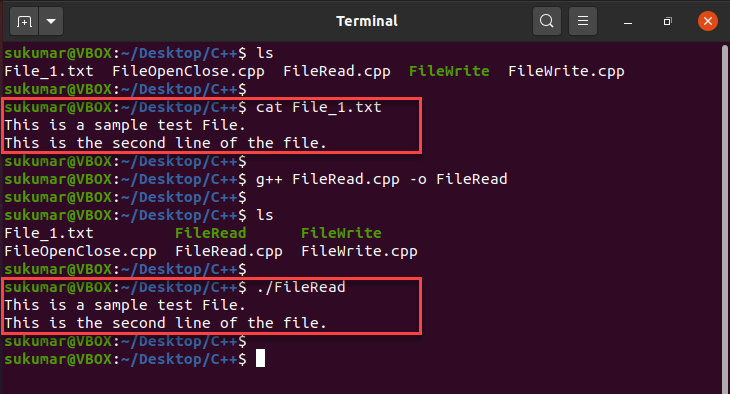
Example four: Read and Write to a File
And so far, we accept showed you how to open up, read, write, and close a file. In C++, nosotros can also read and write to a file at the same fourth dimension. To both read and write to a file, we have to get an fstream object and open the file in "ios::in" and "ios::out" fashion.
In this example, we start write some content to the file. Then, we read the data from the file and print it to the monitor.
#include <iostream>
#include <fstream>
#include <cord>
using namespace std;
int main( )
{
fstream myFile_Handler;
cord myLine;
// File Open
myFile_Handler.open up ( "File_1.txt", ios:: in | ios:: out ) ;
// Cheque if the file has opened
if ( !myFile_Handler)
{
cout << "File did not open up!" ;
exit ( ane ) ;
}
// Write to the file
myFile_Handler << "1. This is another sample test File. " << endl;
myFile_Handler << "2. This is the second line of the file. " << endl;
myFile_Handler.seekg (ios:: beg ) ;
// Read the File
if (myFile_Handler.is_open ( ) )
{
// Keep reading the file
while ( getline(myFile_Handler, myLine) )
{
// print the line on the standard output
cout << myLine << endl;
}
// File Close
myFile_Handler.shut ( ) ;
}
else
{
cout << "Unable to open the file!" ;
}
myFile_Handler.close ( ) ;
return 0 ;
}
Now, we will compile and execute the program.
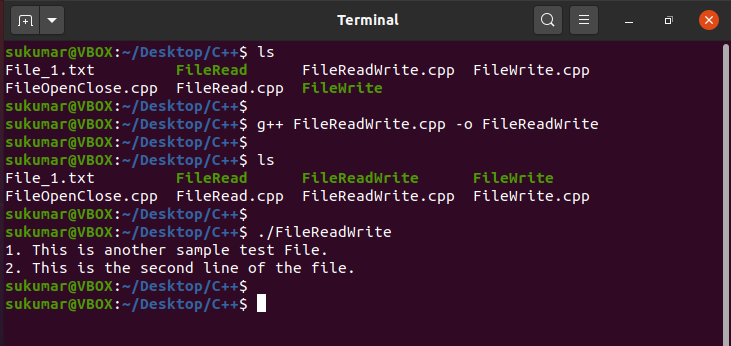
Example 5: Read and Write to a Binary File
In this example, we are going to declare a class and then write the object to a binary file. To simplify this example, we have declared the Employee class with a public variable emp_id. Then, we will read the binary file and print the output to the monitor.
#include <iostream>
#include <fstream>
using namespace std;
course Employee
{
public :
int emp_id;
} ;
int primary( )
{
ofstream binOutFile_Handler;
ifstream binInFile_Handler;
Employee empObj_W, empObj_R;
// File Open
binOutFile_Handler.open up ( "Employee.dat", ios:: out | ios:: binary ) ;
// Check if the file has opened
if ( !binOutFile_Handler)
{
cout << "File did not open up!" ;
leave ( 1 ) ;
}
// Initialize empObj_W
empObj_W.emp_id = 1512 ;
// Write to the file
binOutFile_Handler.write ( ( char * ) &empObj_W, sizeof (Employee) ) ;
binOutFile_Handler.close ( ) ;
if ( !binOutFile_Handler.good ( ) )
{
cout << "Mistake occured during writing the binary file!" << endl;
exit ( 2 ) ;
}
// Now, allow's read the employee.dat file
binInFile_Handler.open ( "Employee.dat", ios:: in | ios:: binary ) ;
// Check if the file has opened
if ( !binInFile_Handler)
{
cout << "File did non open!" ;
exit ( 3 ) ;
}
// Read the content of the binary file
binInFile_Handler.read ( ( char * ) &empObj_R, sizeof (Employee) ) ;
binInFile_Handler.shut ( ) ;
if ( !binInFile_Handler.good ( ) )
{
cout << "Error occured during reading the binary file!" << endl;
exit ( 4 ) ;
}
// Print the output of empObj_R
cout << "Details of the Employee : " << endl;
cout << "Employee ID : " << empObj_R.emp_id << endl;
return 0 ;
}

Conclusion
Files are mainly used to store the data, and they play an important role in real-globe programming. In this commodity, we showed yous how to use diverse file operations with the C++ programming language past working through several examples. Furthermore, we showed you lot how to read and write information into both text files and binary files.
Source: https://linuxhint.com/cplusplus_read_write/
0 Response to "Read and Print Lines From Txt File C++"
إرسال تعليق